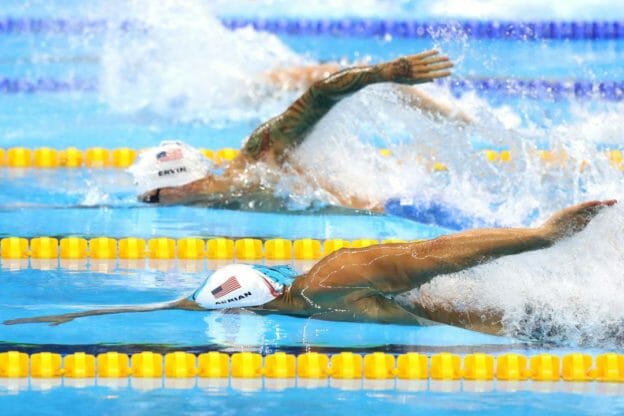How to Recover your arms in Freestyle
In our Race Club video released this week, we teach a freestyle technique that is often overlooked or not appreciated for its importance: freestyle recovery.
What the arm and hand are doing underwater is of profound importance to a swimmer. After all, the pulling propulsion is generated and, depending on the pulling technique, where much frontal drag occurs. So that is where most of the coach’s attention on the swimmer’s technique is focused.
The recovery of the arms over the water is generally looked at as a necessary technique to get the arms back to the front for another pull, with little consequence from how it is accomplished. If that were the case, then the rationale for the recovery motion would be to use as little energy as possible to achieve the task. That would imply that swimmers should bend their elbows on the recovery and swing their arms around to the side back to the front. However, there is much more to the arm recovery than that.
Swimming is not a one-size-fits-all sport. As such, we see a wide variety of freestyle arm recovery techniques, from bent elbow (low octane) to straight arm (high octane) or somewhere in between. While there are always exceptions, most distance swimmers use a bent-elbow recovery, while a majority of sprinters use a straighter-arm recovery technique. There are good reasons for that, which I have explained in previous articles.
What is not often appreciated is the upper arm’s angle, between the shoulder and elbow, with respect to the water as the swimmer recovers the arm over it. That is a metric worth evaluating. At the elite level of Swimming, whether distance or sprinter, the upper arm typically recovers more vertically than horizontally (swinging). The vertical arm recovery involves more work than a more horizontal recovery. Why would we want to make that effort harder, not easier?
Bringing the upper arm more vertically on the recovery requires that the shoulders rotate more during the pulling cycle. The speed of the swimmer’s shoulder rotation (angular velocity) is perhaps the most powerful coupling motion he or she has available to augment the propulsion. It is not how far the shoulders rotate but how fast they rotate that matters during this swimming motion.
In our latest video release, we work with a new competitive swimmer who is trying to conserve energy on his sprint freestyle by swinging the arms to the sides. In effect, by using this technique, he becomes a tire spinning in the sand, losing valuable propulsion and distance per stroke (DPS).
At The Race Club, we use an imaginary string going from the swimmer’s shoulder upward toward the sky or ceiling as a point to draw the elbow toward on the recovery, regardless of whether using a low or high octane recovery. As a coach or swimmer, pay attention to the point your elbow reaches on the recovery or the angle of your upper arm with the water. Try to reach the imaginary string with the elbow, recovering the arm more vertically than horizontally. While this technique may require more work to accomplish, we promise it will return huge rewards in your speed.
Yours in Swimming,
Gary Sr.

